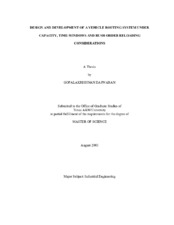| dc.description.abstract | The purpose of this research is to present the design and development of a routing system, custom developed for a fence manufacturing company in the continental US. The objective of the routing module of the system is to generate least cost routes from the home-center of the company to a set of delivery locations. Routes are evolved for a set of customer locations based on the sales order information and are frequently modified to include rush orders. These routes are such that each delivery is made within a given time window. Further, total truckload of all delivery locations over any particular route is not allowed to exceed the weight and volume capacities of the truck.
The basic system modules such as user interface functions and database are designed using MS Access 2000. An interface module to retrieve data from existing ERP system of the company is developed to import pick-ticket information. A customer inter-distance maintenance module is designed with the abilities of a learning tool to reduce information retrieval time between the routing system and the GIS server. The Graphical User Interface with various screen forms and printable reports is developed along with the routing module to achieve complete system functionality and to provide an efficient logistics solution.
This problem, formulated as a mixed-integer program, is of particular interest due to its generality to model problem scenarios in the production shop such as job-shop scheduling, material handling, etc. This problem is coded and solved for instances with different input parameters using AMPL/CPLEX. Results of test runs for the company data show that the solution time increases exponentially with the number of customers. Hence, a heuristic approach is developed and implemented. Sample runs with small instances are solved for optimality using AMPL/CPLEX and are used to compare the performance of the heuristics. However, test runs solved using the heuristics for larger instances are compared with the manual routing costs. The comparison shows a considerable cost savings for heuristic solutions. Further, a what-if analysis module is implemented to aid the dispatcher in choosing input parameters based on sensitivity analysis. In conclusion, further improvement of the routing system and future research directions are proposed. | en |


